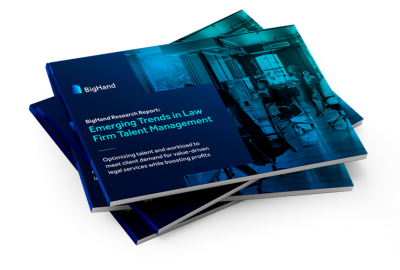Recent data from BigHand highlights ongoing pressures from rising client attrition and talent turnover, exacerbated by changing client expectations and internal resource issues. While revenue growth is important, these underlying challenges must be addressed to ensure long-term success. In this article, a strategic response to these pressures will be explored, focusing on how firms can leverage technology and refine talent management practices.
Client Attrition and Evolving Expectations
A concerning statistic from BigHand's report reveals that 96% of firms lost clients in the past year. A contributing factor to this trend seems to be the shift in clients' expectations. The report shows that increasingly, clients prioritize cost-efficiency, with 33% finding cheaper legal services elsewhere, and 34% reducing the number of firms on their panels. The firms that remain on these reduced and refocused panels are likely those that can adapt to the evolving needs of their clients. Given this shift, firms should be especially concerned, as failing to meet these changing demands could lead to further client attrition and a diminished competitive position in an already tightening market.
We’re also seeing clients focus on diversity, equity, and inclusion (DEI), with 33% of firms reporting client losses to competitors that meet their DEI criteria. While 87% of firms report an increase in client requests for DEI data around matter staffing, just 19% say DEI is a priority when resourcing matters, and 47% lack the tech to provide reporting on DEI across matters altogether. This data shows us that there is massive room for improvement when it comes to firms delivering on this demand from clients – it's now more important than ever for firms to prioritize DEI initiatives.
So, how can firms effectively show their value and reduce client attrition? The answer lies in data. Tech-driven firms lead the pack, with 64% showcasing efficiency gains through technology in RFIs. This stat tells us:
- Firms embracing technology are achieving efficiency gains.
- They’re responding to changing client expectations.
- Technology gives them a clear way to demonstrate value to clients.
Top Talent on the Move
It’s not just clients that firms need to be concerned about losing— the bullish lateral hire market continues to present challenges, with movement at senior levels reported by 53% of firms. A commonality between client and talent attrition: a change in expectation. Lawyers are being drawn increasingly toward firms offering a better work-life balance, hybrid work options, and clear paths for career advancement. This is supported by data: 25% of equity partners have identified the absence of hybrid work, while 23% have cited insufficient professional development as the main reasons for leaving their firms. Firms should take note, because failing to meet these expectations could lead to further movement of top talent, weakening both their workforce and competitive edge.
Flexible work arrangements, transparent career pathways, and opportunities for professional development must be provided to ensure employees feel valued and satisfied. The targeted use of technology can provide visibility to an, at times, opaque process. For instance, BigHand Resource Management can be used to align workloads with career goals and skill sets, ensuring top talent remains engaged with meaningful work. In addition to the visibility of workloads, leveraging technology enables the hybrid work environment that many new hires expect. Firms with better attrition rates have set the expectation that utilizing such tools is essential for retaining their talent and maintaining productivity in a competitive market.
Operational Efficiency and the Role of Support Staff
Talent attrition is not limited to senior staff; over two-thirds of firms have reported losing support staff, which has negatively impacted both productivity and profitability. Operational efficiency depends heavily on making the most of support staff, yet many firms continue to struggle with proper work delegation. For example, 12% of lawyers spend over five hours a week on non-billable, client-facing, or internal administrative tasks (and this figure may be even higher at several firms). This creates a gap in utilization. While such tasks are essential to client service, they should ideally be handled by support staff, allowing lawyers to focus on billable work, where their skills are most valuable.
Without proper support systems, lawyers are often left with no choice but to manage administrative tasks on their own. Centralized, data-driven support models, enabled by workflow technology, are key to improving both service delivery and resource allocation. By using these tools, firms can ensure that tasks are appropriately assigned, giving lawyers the necessary support to maximize their productivity. This technology also offers crucial visibility into task delegation, something that is especially challenging in larger firms. In fact, 68% of firms have acknowledged that greater visibility into the activity of support staff improves understanding of their contribution to lawyers’ work. Such visibility is essential for the efficient allocation of resources, which in turn strengthens productivity and profitability.








